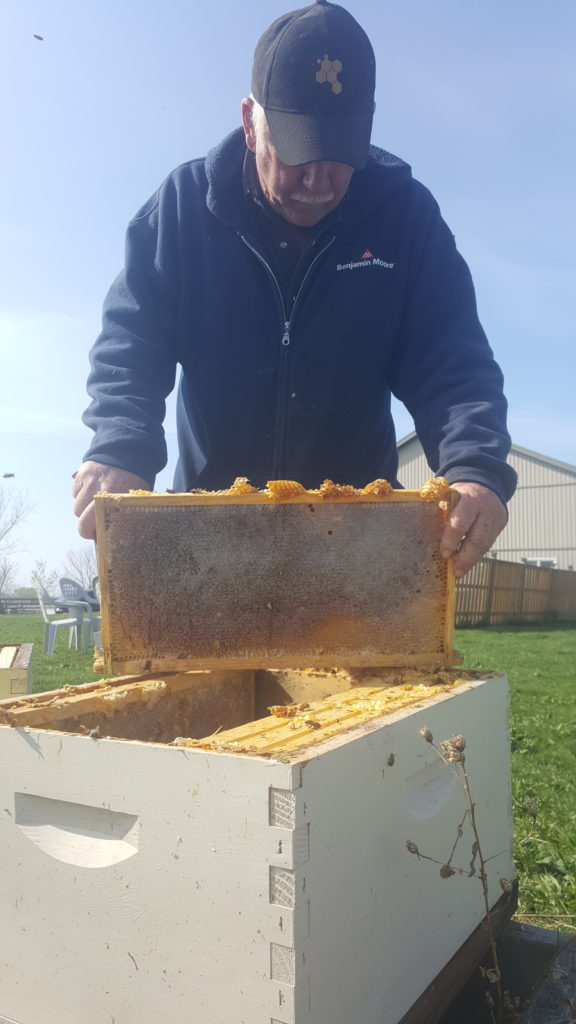The Buzz
Inspecting the hive, what to look for?
Inspecting the Hive
Inspecting hives should be a regular routine. If you can check hives once a week that would be beneficial but for many that could be an impossible task due to the amount of hives and locations they might be in. Try not to go more than two weeks if possible. A good regular routine of checking in on hives reduces your chances of having very big negative effects to your colonies. It doesn’t take long for an infestation to take over a hive. In this post we will discuss a few issues to look out for.
The first known pest is the waxworm or to many beekeepers the wax moth. 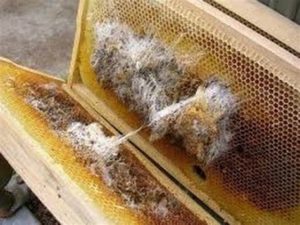 In the wild, they live as nest parasites in bee colonies and eat cocoons, pollen, and shed skins of bees, and chew through beeswax, thus the name. Beekeepers consider waxworms to be pests. Galleria mellonella (the greater wax moths – WIKI: https://en.wikipedia.org/wiki/Galleria_mellonella) will not attack the bees directly, but feed on the wax used by the bees to build their honeycomb. Their full development to adults requires access to used brood comb or brood cell cleanings—these contain protein essential for the larvae’s development, in the form of brood cocoons. The destruction of the comb will spill or contaminate stored honey and may kill bee larvae or be the cause of the spreading of honey bee diseases. (excerpt from WIKI: https://en.wikipedia.org/wiki/Waxworm).
In the wild, they live as nest parasites in bee colonies and eat cocoons, pollen, and shed skins of bees, and chew through beeswax, thus the name. Beekeepers consider waxworms to be pests. Galleria mellonella (the greater wax moths – WIKI: https://en.wikipedia.org/wiki/Galleria_mellonella) will not attack the bees directly, but feed on the wax used by the bees to build their honeycomb. Their full development to adults requires access to used brood comb or brood cell cleanings—these contain protein essential for the larvae’s development, in the form of brood cocoons. The destruction of the comb will spill or contaminate stored honey and may kill bee larvae or be the cause of the spreading of honey bee diseases. (excerpt from WIKI: https://en.wikipedia.org/wiki/Waxworm).
The second known pest is the varroa mite. This little pest is one to look for and try to keep populations low to none if possible. These are very small and much harder to see, need to look carefully at the bees.

Preferred feeding location of Varroa destructor mites on adult host bees.
Varroa destructor (Varroa mite) is an external parasitic mite that attacks and feeds on the honey bees Apis cerana and Apis mellifera. The disease caused by the mites is called varroosis.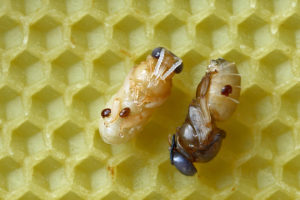
The Varroa mite can reproduce only in a honey bee colony. It attaches to the body of the bee and weakens the bee by sucking fat bodies. The species is a vector for at least five debilitating bee viruses, including RNA viruses such as the deformed wing virus (DWV). A significant mite infestation leads to the death of a honey bee colony, usually in the late autumn through early spring. The Varroa mite is the parasite with possibly the most pronounced economic impact on the beekeeping industry. Varroa is considered to be one of multiple stress factors contributing to the higher levels of bee losses around the world. (excerpt from WIKI: https://en.wikipedia.org/wiki/Varroa_destructor).
The third known pest is the Small Hive Beetle. 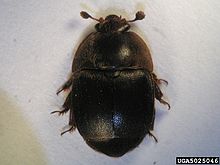 This little hive pest originates from Africa and has spread across many parts of the beekeeping world. If unchecked these little pests can devastate a hive.
This little hive pest originates from Africa and has spread across many parts of the beekeeping world. If unchecked these little pests can devastate a hive.
The beetle is most often found in weak or failing hives and 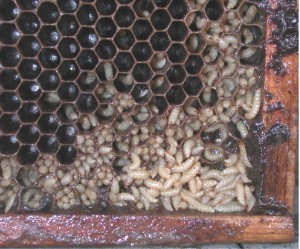 rarely affects strong hives. There are many ways to rid your hives of the small hive beetle such as traps, nematodes, non-toxic oils or chemical treatments (chemical treatments are to be followed as per manufactures instructions). We recommend traps around the bee yard and adding burnt ash around the hives. When inspecting your hive and if you see any hive beetles, kill what you can.
rarely affects strong hives. There are many ways to rid your hives of the small hive beetle such as traps, nematodes, non-toxic oils or chemical treatments (chemical treatments are to be followed as per manufactures instructions). We recommend traps around the bee yard and adding burnt ash around the hives. When inspecting your hive and if you see any hive beetles, kill what you can.
The fourth known pest, foulbrood, is not as common but very dangerous to a hive, bee yard and surrounding apiaries.
Foul Brood is something no beekeeper ever wants to see amongst their hives. There are currently two forms of foulbrood:
1) The American Foulbrood (AFB) which is caused by a spore-forming bacterium called Paenibacillus larvae.
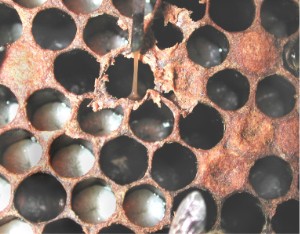 Field test for American foulbrood
Field test for American foulbrood
2) European Foulbrood (EFB) which is caused by the bacterium Melissococcus plutonius. This is not a spore forming bacterium.
Both variations of foulbrood are not good for any hive but American Foulbrood is far more devastating than the European version. In Canadian apiaries little is known about foulbrood strains.
American Foulbrood (AFB)
These spores are the infective stage of the disease and infection begins when food contaminated with spores are fed to larvae by the nurse bees. Once in the gut of the larva the spores germinate, bacteria move into the larval tissues, where they multiply enormously. Infected larvae normally die after the cell is sealed and millions of infective spores form in the larval remains. P. larvae spores remain viable for many years and are very resistant to extremes of hot and cold and to many disinfectants.
Clinical signs – AFB
This disease affects sealed brood and has characteristic disease signs, which may include the following:
• uneven ‘pepper-pot’ brood pattern
• darkened, sunken, greasy cell cappings
• preformatted cell cappings
• sticky larval remains which can be drawn out with a matchstick (‘ropiness test’)
• hard, dark scales which are difficult to remove from cells
European Foulbrood (EFB)
Larvae become infected by consuming contaminated food fed by the nurse bees. The bacteria multiply within the larval gut, competing with it for food. They remain in the gut and do not invade larval tissue; larvae that die from the disease do so because they have been starved of food. This normally occurs shortly before the cells are capped.
Clinical signs -EFB
This is primarily a disease of the unsealed brood and symptoms typically include:
• erratic or uneven brood pattern
• twisted larvae lying unnaturally in the cell
• discoloured larvae
• larvae which have a melted appearance (no segmentation)
• an unpleasant sour smell
With both variations of foulbrood, they can be spread with contaminated tools, equipment or clothing and can even transfer on the bees. There are a few methods to diagnose if you have foulbrood. One method is taking a toothpick or something similar and do the ropiness test, another method is to purchase a foulbrood test kit from your beekeeping supply store, the Holst milk test looks promising but needs more patience, there is another method to use a blacklight due to the scales glow, and the most accurate besides the AFB test kit is to send a sample into a lab for analysis.
Which ever method you prefer, if you show signs of being positive, it is recommended that you contact an API Inspector right away. Most likely if you have a foulbrood problem you will have to clean all tools and clothing thoroughly and burn bees and equipment. You can save some parts by scraping all wax and propolis from woodware then lightly burn everything with a torch until light brown. This could solve your problem but the surest way to rid yourself of foulbrood is to start fresh and new. It’s an unfortunate mishap but this is why it is very important to have the proper husbandry practices in place when beekeeping and inspect your hive regularly.
We are not trying to scare you but you need to be aware of the possible risks of foulbrood infestation. To put you more at ease, foulbrood is rare and is not common in most of Canadian Apiaries. If you do see signs of foulbrood please isolate the infected hive and get it inspected and tested right away.
If you are located in the Greater Niagara Region do not hesitate to give us a call at: 905.984.4408
We will be more than happy to help you and guide you in the right direction if you are experiencing any hive issues. (*Note: Some services might have a cost associated with the time and/or treatments involved)
These are the locations we service and everything in between:
Niagara Falls, Port Colborne, St. Catharines, Thorold, Welland, Fort Erie, Grimsby, Lincoln, Niagara-on-the-Lake, Pelham, Wainfleet, West Lincoln and Hamilton


